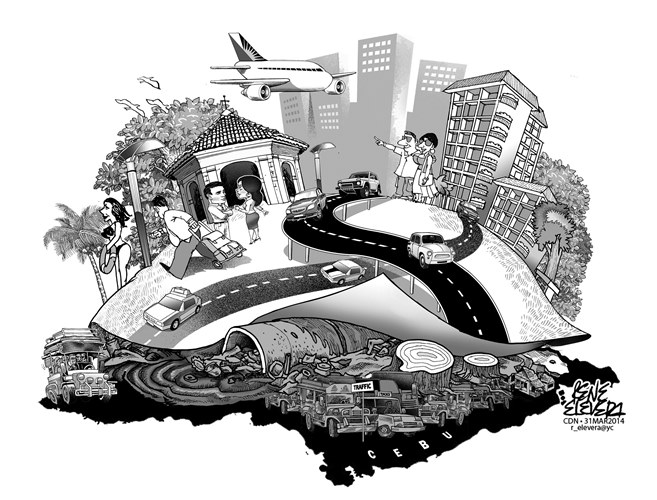The dream of reshaping reality into livable cities is a quest for survival itself.
Part of the vision is to have roads not choked with vehicular traffic but instead to have lanes with space for all users – wide, well-lit sidewalks where people can walk safely, bicycle paths and an efficient mass transit – amid greenery and clean air.
The metropolis – Metro Cebu in all its messy glory – has 2.5 million people scrambling for a decent way of life. Demographers estimate that by 2050, which is half-a-generation away, the population would have tripled.
Mindless growth will transform this fast-urbanizing place that we call home into a polluted trap.
Cebu City as the capital can’t waste more time in this challenge.
Sunday, March 30, was supposed to be a step forward for five pilot areas in the country, including Cebu City, to push for “road sharing”. A symbolic exercise would have given Cebuanos a taste of pedestrian power.
The plan was to have a 1.5-meter section of Gorordo Avenue in barangay Lahug marked for bike lanes so that citizens could use part of it on Sunday for cycling, walking or even roller skating. The experiment would have extended to dry runs every Sunday for six months.
By showing it can be done, other national roads could follow.
Unlike the “Road Revolution” of June 12, 2011, where the entire length of Osmeña Boulevard was liberated for pedestrians and the city’s longest road was transformed into a park and promenade for the day, road sharing accepts the reality that cars and commuters belong on the road as well.
What happened?
Cebu City, cradle of the road-sharing concept, passed up the chance to lead the kickoff of National Road Sharing Day.
No bike lanes were ready in Lahug. Eco-lawyer Golly Ramos lamented the foot-dragging of the Department of Public Works and Highways (DPWH) whose staff said they were still waiting for a memo from their head office to mark out the national road.
Sayang. We waived the initiative in favor of other cities of Iloilo, Marikina, San Juan and Pasay, which hosted their own pedestrian-happy activities.
What a wasted opportunity to strike a blow for change.
A bike lane ordinance sponsored by Councilor Nida Cabrera passed on first reading last week. We heartily support the ordinance, knowing that it faces an uphill climb because the road network in Cebu City is a disorganized patchwork of stop-and-start repairs.
In the summer heat, road sections in Cebu, Mandaue and Lapu-Lapu cities are being ripped up by DPWH contractors in the name of rehabilitation. This is a classic example of busy work with little coordination with local governments, following no coherent, integrated plan.
The national roads will undergo a cosmetic change – thicker concrete, a layer of asphalt to cover potholes, additional drainage culverts, but not a better design.
Wider lanes, properly defined for vehicles and pedestrians, would have improved the whole layout for urban transportation.
Who has time to lose anymore?
It will take longer to change mind-sets than fill potholes to jar us out of complacency with thinking that Cebu City is still “second to none”.
Disclaimer: The comments uploaded on this site do not necessarily represent or reflect the views of management and owner of Cebudailynews. We reserve the right to exclude comments that we deem to be inconsistent with our editorial standards.

